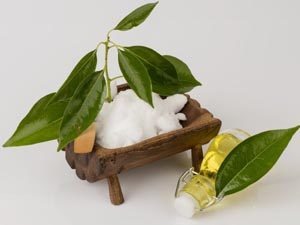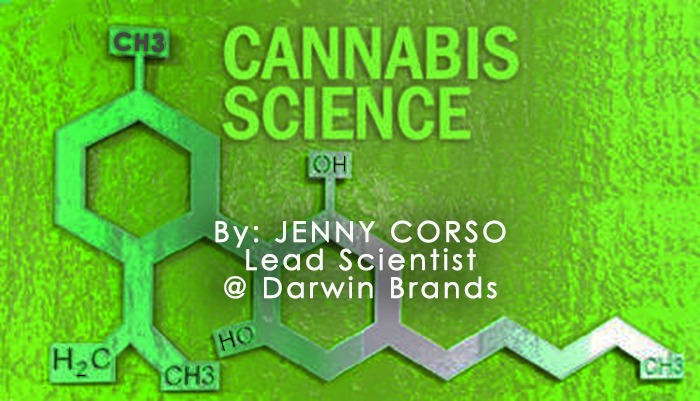BY JENNY CORSO, CHIEF SCIENTIST, DARWIN BRANDS
The cannabis industry has a budding love affair with terpenes, not only because they provide each chemovar with its own distinct smell, but strongly dictate the effect and therapeutic value of each strain, as well.
Under the vast umbrella of phytochemicals, the group of biologically active and beneficial compounds found in plants, are the molecules responsible for the unique sensory characteristics associated with each individual species, terpenes included.
But not all aromatics are terpenes, even though they are in fact the largest group of phytochemicals we know of. Technically and chemically speaking, the only compounds that can be considered terpenes are hydrocarbons made up of isoprene units, as terpenes structurally contain only carbon and hydrogen (you can geek out about them in our article, here).
Sensory stimulating molecules that contain other atoms, like oxygen, are not terpenes. If they happen to be derived from them, they are considered terpenoids (yes, these words are similar but not synonymous). If the compounds are not derived from terpenes, they are classified appropriately based on their structure.
Here’s a basic rundown of other important groups of organoleptic (sensory effecting) compounds found in cannabis that have therapeutic value
Phenolic Compounds
This group of compounds is vast and only second in abundance to terpenes. Some researchers believe more than 10,000 structures can be classified here, including polyphenols, flavonoids and flavonols, as well as lignans.
From a therapeutic perspective, phenols and polyphenols are very potent, typically presenting antiseptic, neural and immuno-stimulating properties. Many of them act as pro-oxidants, stimulating endogenous antioxidant upregulation.
Phenols are technically derived from phenylpropene, although some are synthesized from terpenes and can therefore be called phenolic terpenoids. Certain essential oils contain high concentrations of phenols, such as clove and thyme, and due to their astringent nature, may irritate the skin.
A few examples?
Eugenol found in clove and cinnamon, has been shown to have antibacterial properties against E. coli and S. aureus (responsible for MRSA). Eugenol is not derived from a terpene, therefore it is a true phenolic compound.
Anethole is a phenolic ether and derivative of phenylpropene. Found primarily in anise, it is believed to possess hypoglycemic properties, with positive impacts on blood sugar in studies investigating its use in hyperglycemic, type 2 diabetic rats. It comes in two isomers, cis and trans, the former which can be toxic. Both eugenol and anethole can be found in some cannabis strains.
Cannabis also has a set of flavones unique to it, called cannflavin A and B, thought to be potent anti-inflammatory compounds. It also produces cannabis-specific lignanamides, cannabisin-A through G, which may have antioxidant effects and also act as acetylcholinesterase inhibitors, perhaps enhancing focus and memory.

Aldehydes and Ketones
These two groups of molecules can be discussed together simply based on their closeness in structure. Aldehydes are known for having very strong aromas and may calm the nervous system, the opposite neuro- physiological effect of many phenols. This is one reason why full-spectrum extracts are more powerful than the isolated constituents – there is an inherent and natural balance of phytochemicals that is hard to replicate otherwise, illustrated simply by this example.
A notable aldehyde found in citrus fruit, lemon balm and cannabis, is citral. Known for its sharp, lemony citrus scent and susceptibility to induce allergic reactions, it’s a strong antiseptic and believed to be effective agent against MRSA. Citral is highly advised to be used with caution, however studies suggest that its toxicologic attributes can be ameliorated (or “quenched”) when combined with other aromatics, such as the terpene D-limonene.

Ketones are not as abundant in essential oils as other aromatics. They are known to be calming, have been reported to be beneficial to the skin when used in topical formulations, and may also promote wound healing. Ketones are found in higher concentrations in peppermint, spearmint and jasmine, and wormwood. (Thujone is the agent responsible for adverse effects associated with consuming absinthe).
Examples of ketones: Camphor is a minty ketone terpenoid commonly found in cannabis, and is one of the active ingredients in Vicks Vaporub, yet it still classified as toxic. The ketone pugelone is also found in cannabis. An interesting fact about pugelone? It is the toxic compound found in pennyroyal and has been known to also cause epileptic fits when consumed in high doses.
The Therapeutic Takeaways
When creating cannabis formulations that contain a variety of aromatics, it is essential to understand how Mother Nature formulates her chemovars organically. Each compound, whether a terpene or other aromatic, has a naturally occurring concentration threshold that can define the difference between therapeutically beneficial and hazardous.

Need a good example? The Earl Grey vape cartridge produced by Darwin Brands contains a proprietary blend of more than 15 individual aromatic compounds plus a full-spectrum extract of organic, bergaptene-free bergamot oil. Why bergaptene-free? Studies show bergamot oil can cause photosensitivity, bergaptene (a furanocoumarin) being the major culprit. Otherwise, when used in a naturally occurring therapeutic ratio to other compounds, bergamot oil can induce a relaxing and anti-anxiety effect, and that is precisely how this product was formulated to ensure a safe, effective and tasty experience.
Until next time, smell ya later!




